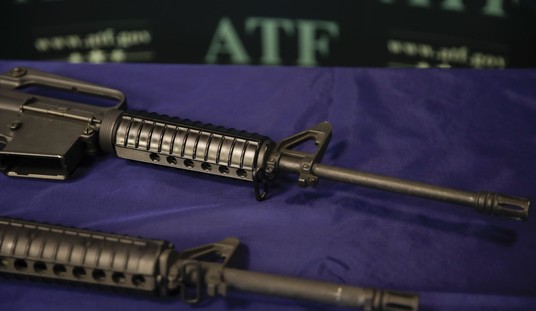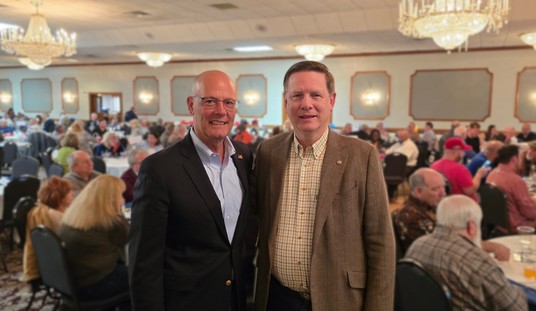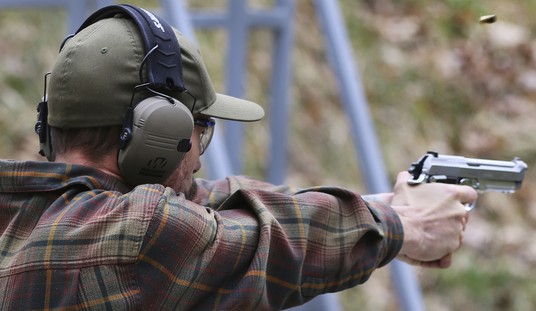The Fourth Circuit Court of Appeals took up Maryland's ban on so-called assault weapons today, and several judges indicated that they may want to send the case back down to the district court rather than issuing a ruling themselves on the constitutionality of the ban. That would be an extraordinary step for the appeals court to take, but it wouldn't be the first time that the judges have played games with the litigation.
In fact, today's en banc hearing was unusual in and of itself, since the full court intervened to take the case en banc before a three-judge panel had the opportunity to issue its opinion in Bianchi v. Brown. The Fourth Circuit didn't give a reason for taking that nearly unprecedented action, but there's a strong suspicion in Second Amendment circles that a majority of judges on the appellate court wanted to preempt a decision that would have found the state's ban a violation of the right to keep and bear arms.
Oral Arguments at the Fourth Circuit in Bianchi v. Brown just ended, and a few judges now want to send the case down to the District Court AGAIN.
— Firearms Policy Coalition (@gunpolicy) March 20, 2024
One thing is sure: the delay tactics are out of control, and the proper remedy is for SCOTUS to grant our request for intervention. pic.twitter.com/uIiyEnrOFJ
I was busy doing a VIP Gold Live chat with my pal Ed Morrissey from Hot Air while the oral arguments were underway, so I didn't have a chance to listen live. Based on the thread from the Firearms Policy Coalition, it's probably a good thing I didn't because I probably would have thrown my laptop out the window listening to some of the B.S. spewed by the judges.
WE ARE LIVE!
— Firearms Policy Coalition (@gunpolicy) March 20, 2024
🧵👇 https://t.co/MCn1kPuw4D pic.twitter.com/hp5bLRpOUY
I encourage you to read the entire thread yourself, though you should probably do some deep breathing exercises before you start scrolling through stuff like this.
The M16 judge keeps saying that the AR being like the M16 means it is one and that it can be banned
— Firearms Policy Coalition (@gunpolicy) March 20, 2024
I'm not sure what judge FPC was referring to, but it may have been Harvie Wilkinson, who not only took issue with the facial challenge to the entire statute but repeatedly compared M16s to AR-15s during the hearing.
Wilkinson also pointed to former U.S. Supreme Court Justice Antonin Scalia's 2008 opinion in the landmark case District of Columbia v. Heller. Heller held that the Second Amendment protects an individual's right to possess a firearm unconnected with service in a militia and to use that arm for traditionally lawful purposes, such as self-defense within the home. Relevant is that Scalia also wrote that weapons may be banned if they are most useful in military service — "M16 rifles and the like."
"Have you ever fired an M16," Wilkinson, who served in the army reserves during the Vietnam War, asked. "The kick was so powerful that when a bullet struck a human being, it splintered them in all sorts of different pieces. There was very little left of the human being."
Patterson said the idea of banning guns because they're useful in war contradicts their purpose.
"The Second Amendment, as Heller said, was put into the Constitution to preserve the militia, which was valued for things like putting down insurrections and repelling invasions," Patterson said. "The notion that a firearm cannot be protected because of its military utility would make no sense."
Wilkinson also said the weapons in the case before them strayed from Bruen and Heller.
"These are dramatically different weapons that are before us in this case than the handgun statutes and handgun regulations that were at issue in Bruen and Heller," Wilkinson said. "This is a whole jump up. It's a different level of magnitude."
No, it's really not. The Supreme Court said in Heller that “the Second Amendment extends, prima facie, to all instruments that constitute bearable arms, even those that were not in existence at the time of the founding.”
In other words, courts should start from the position that bearable arms are protected under the Second Amendment. If the state can show that a particular firearm is "dangerous and unusual" (not "dangerous or unusual", or "unusually dangerous", as some judges have twisted the Supreme Court's statement), then a case can be made that the arms in question fall beyond the Second Amendment's protections.
Arms that are "in common use for lawful purposes" including (but not limited to) self-defense, however, are covered by the right to keep and bear arms. The Fourth Circuit panel seemed to be intent on figuring out a way to deny that the semi-automatic firearms banned by the state of Maryland are in common use, even though there are more AR-15s lawfully possessed in this country than there are Ford F-150s; the most common pickup truck in the U.S.
The judges debated what the threshold is for considering something in common use. Patterson argued that it is common use if over a million Americans use it, like the popular AR-15. U.S. Circuit Judge Pamela Harris, a Barack Obama appointee, pushed back.
"What percentage of Americans is that?" Harris asked. "Under 1% is common use?"
Patterson likened the number of semiautomatic weapons to electric vehicles. Patterson cited statistics showing that the U.S. has 3 million electric cars, yet they are still considered in common use.
Chief U.S. Circuit Judge Albert Diaz, another Obama appointee, asked Patterson whether any weapon could be banned if it was in common use.
"So a state cannot ban a machine gun, assuming there had been no federal ban," Diaz asked. "What about a bazooka being used for recreational purposes? A tactile nuclear weapon?"
Patterson responded that the situation would not happen because the American people use common sense and would not buy weapons they do not need for self-defense.
I don't think my laptop would have survived to relay Patterson's response if I'd been listening live. I hate stupid hypotheticals like the one posed by Diaz. We're not talking about bazookas or tactical nukes here. We're talking about some of the most popular semi-automatic rifles, shotguns, and even some handguns in the United States. There are more than 20 million AR-15s that are lawfully possessed in this country, and those guns are used far more frequently for lawful purposes like self-defense, recreational shooting, and hunting than they are for criminal purposes.
So what happens next? Well, the best case scenario is that the Supreme Court grants the emergency cert petition requested by FPC after seeing that the Fourth Circuit is still jerking the plaintiffs around by threatening to kick the case back down to district court instead of deciding the case on the merits.
The second-best option would be for the Fourth Circuit to issue its decision in a timely manner, even though it's pretty clear that the en banc panel is going to uphold Maryland's ban. So long as the appellate court doesn't keep its opinion under wraps for months on end, the plaintiffs could bring their case to SCOTUS promptly on a non-emergency basis.
The worst case scenario is the Fourth Circuit holding on to Bianchi for a prolonged period of time, and then deciding that it's best for the district court to have a do-over, which could keep the case away from SCOTUS for several more years.
I wish I could say that option is probably off the table, but unfortunately, I think there's a decent chance that the Fourth Circuit will choose Door #3. Here's hoping that SCOTUS will take that option off the table by granting FPC's cert petition and finally declare that making the most commonly-owned rifles in the country off-limits to lawful gun owners is indeed an infringement on their right to keep and bear arms.









